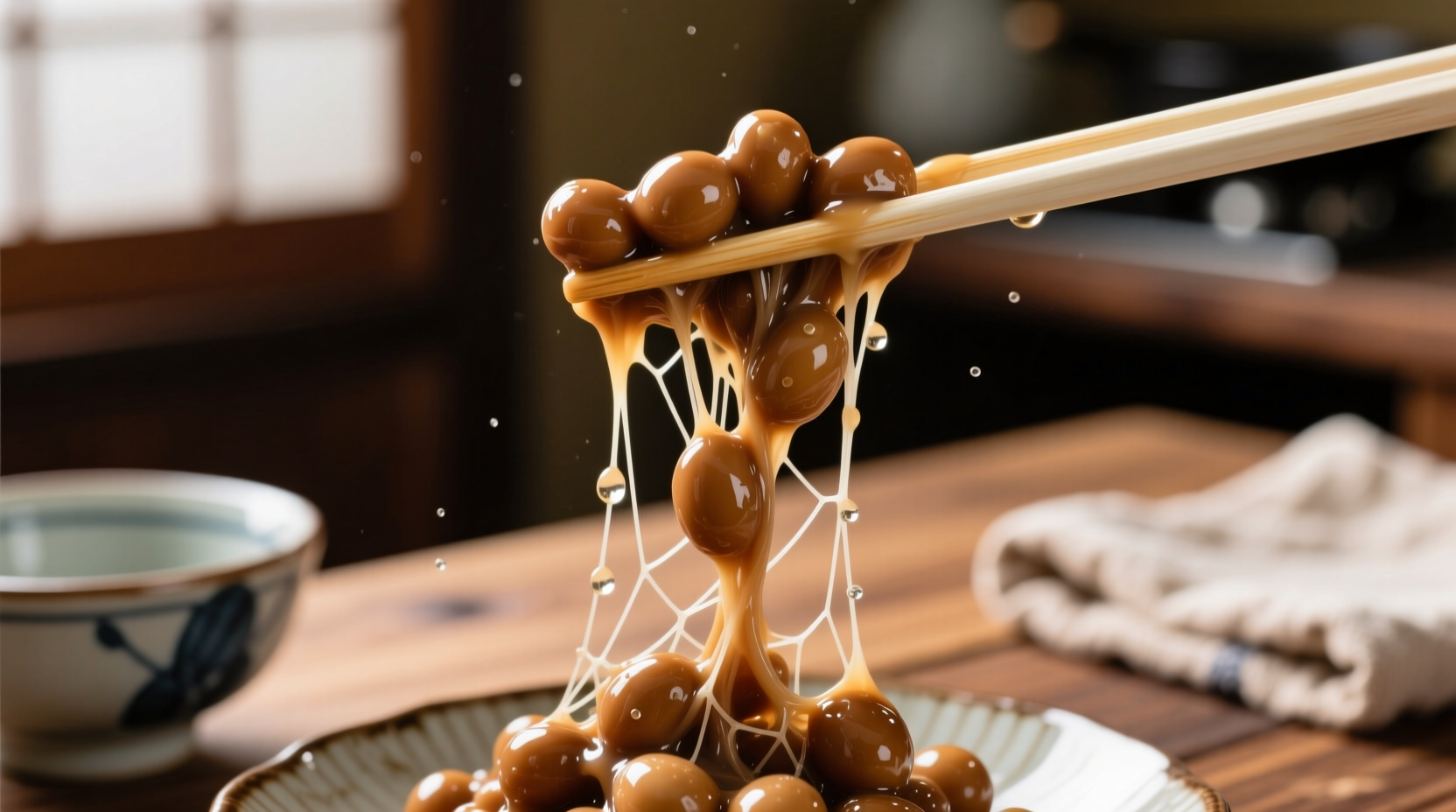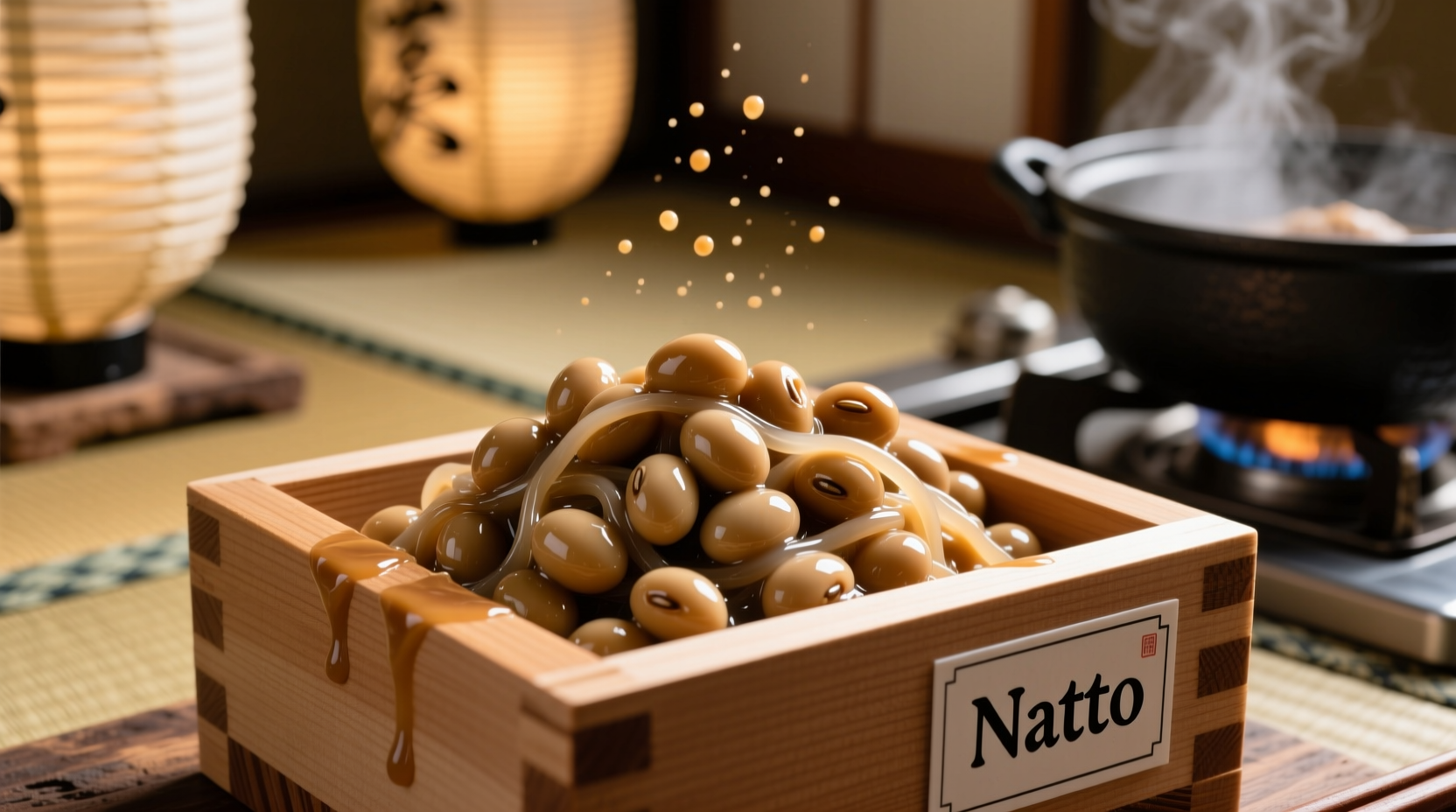Ever wondered what does natto taste like when you first encounter this traditional Japanese food? This fermented soybean dish delivers a powerful sensory experience unlike anything in Western cuisine. Understanding natto's flavor profile helps both curious food adventurers and those planning their first taste.
The Aroma: Your First Encounter with Natto
Before you even taste natto, its aroma hits you. Described by many as similar to aged cheese or ammonia, this pungent smell comes from the Bacillus subtilis bacteria used in fermentation. Scientific analysis shows natto produces volatile compounds including ammonia, pyrazines, and aldehydes that create its signature scent. While off-putting to some, experienced eaters recognize this aroma as a sign of proper fermentation.
| Fermented Food | Primary Aroma Notes | Intensity Level |
|---|---|---|
| Natto | Ammonia, earthy, nutty | ★★★★★ |
| Miso | Savory, salty, umami | ★★★☆☆ |
| Kimchi | Spicy, sour, garlicky | ★★★★☆ |
| Blue Cheese | Pungent, creamy, tangy | ★★★★☆ |
Texture: The Signature Stringiness
When you lift natto with chopsticks, you'll notice its famous stringy texture. This viscous quality comes from polyglutamic acid produced during fermentation. The slimy strands aren't just visual—they affect how natto feels in your mouth. Properly fermented natto should have a consistent stickiness without being watery or dry. Food scientists at Tokyo University have measured natto's viscosity at approximately 1,500-2,000 centipoise, explaining why it creates those distinctive strings.

Flavor Profile: Beyond the Initial Shock
Once past the aroma, natto reveals its complex flavor profile. The primary taste sensation is intense umami from the breakdown of soy proteins into amino acids like glutamate. You'll detect:
- Savory depth - similar to aged soy sauce but more concentrated
- Earthy undertones - reminiscent of mushrooms or forest floor
- Subtle nuttiness - particularly in traditionally prepared natto
- Mild saltiness - from the fermentation process (not added salt)
Unlike many fermented foods, natto doesn't have significant sourness. The fermentation process creates a slightly alkaline environment rather than acidic, resulting in that distinctive savory rather than tangy profile.
Fermentation Timeline: How Natto Develops Its Flavor
Understanding what does natto taste like requires knowing how fermentation transforms the beans. Here's the flavor development timeline:
- 0-12 hours: Soybeans soften but retain bean flavor with minimal fermentation
- 12-24 hours: Initial stickiness appears with mild umami development
- 24-36 hours: Optimal fermentation period with balanced flavor and texture
- 36-48 hours: Stronger aroma intensifies with more pronounced umami
- 48+ hours: Over-fermentation creates unpleasant ammonia notes
Japanese food standards specify that properly fermented natto should be consumed within 36-48 hours after fermentation begins for the best flavor balance. Temperature control during this process significantly affects the final taste profile.
Cultural Context: How Japanese People Experience Natto
In Japan, natto isn't just food—it's a cultural institution. Most Japanese children grow up eating natto for breakfast, often mixed with rice, green onions, and a raw egg. The Japanese Ministry of Agriculture recognizes over 300 regional variations of natto, each with subtle flavor differences based on local fermentation practices.
When asking what does natto taste like for first time eaters, Japanese food experts note that palates adapt over time. A 2023 survey by the Japan Natto Association found that 78% of people who initially disliked natto learned to appreciate it after 3-5 exposures when prepared traditionally.
Practical Tips for First-Time Tasters
If you're wondering is natto supposed to smell bad, the answer is yes—but that's part of its authentic character. Here's how to approach your first taste:
- Stir vigorously - 400+ times to activate the enzymes and mellow the flavor
- Pair with rice - The starch balances natto's intensity
- Add traditional condiments - Soy sauce, mustard, and green onions complement the flavor
- Try chilled - Cold temperature reduces the aroma's intensity
- Start small - A single bean-sized portion helps your palate adjust
When Natto Tastes 'Wrong': Quality Indicators
Not all natto tastes the same. Understanding how to describe natto taste helps identify quality issues:
- Good natto: Balanced umami with earthy notes, consistent stickiness, fresh aroma
- Over-fermented: Strong ammonia smell, watery texture, unpleasant aftertaste
- Under-fermented: Minimal stickiness, bland flavor, hard bean texture
- Contaminated: Mold growth, sour smell, inconsistent color
The Japanese Agricultural Standard specifies that high-quality natto should have a pH between 7.5-8.5. Values outside this range indicate improper fermentation that affects the final taste.
Why Natto Tastes This Way: The Science Behind the Flavor
Natto's distinctive flavor comes from enzymatic breakdown during fermentation. As Bacillus subtilis works on soybeans, it produces:
- Glutamic acid - Creates intense umami sensation
- Polyglutamic acid - Responsible for sticky texture
- Vitamin K2 - Contributes to earthy notes
- Various peptides - Add complexity to the flavor profile
Research published in the Journal of Agricultural and Food Chemistry confirms that properly fermented natto contains over 200 volatile compounds that contribute to its complex aroma and taste profile.
Common Pairings That Balance Natto's Flavor
Traditional Japanese pairings help moderate natto's intensity while enhancing its positive qualities:
- Rice - The neutral starch base absorbs natto's stickiness
- Raw egg - Creates creamy texture that tempers strong flavors
- Green onions - Fresh bite cuts through earthiness
- Soy sauce - Enhances umami without overpowering
- Mustard - Sharpness balances the fermented notes
For those still learning what does natto taste like with different accompaniments, Tokyo's culinary schools teach that the classic "natto don" (rice bowl) with these five components creates the ideal flavor balance.
Developing a Palate for Natto: A Journey Worth Taking
Many people ask why does natto have strong smell yet remains popular in Japan. The answer lies in its nutritional benefits and cultural significance. With repeated exposure, your taste buds adapt to appreciate natto's complex flavor profile. Food scientists describe this as "umami literacy"—the ability to recognize and appreciate deep savory flavors that initially seem overwhelming.
Whether you're exploring Japanese cuisine or seeking fermented food benefits, understanding what does natto taste like prepares you for this unique culinary experience. Approach it with an open mind, follow traditional preparation methods, and give your palate time to adjust—you might discover a new favorite food.











 浙公网安备
33010002000092号
浙公网安备
33010002000092号 浙B2-20120091-4
浙B2-20120091-4